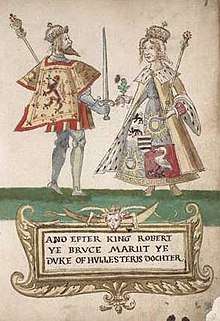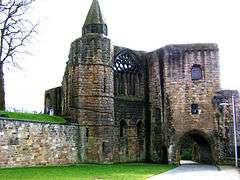Elizabeth de Burgh
| Elizabeth de Burgh | |
|---|---|
 Robert the Bruce and Elizabeth de Burgh, from the Seton Armorial. | |
| Queen consort of Scotland | |
| Tenure | 1306–1327 |
| Coronation | 27 March 1306 |
| Born |
c. 1284 County Down or County Antrim |
| Died |
27 October 1327 Cullen, Banffshire |
| Burial | Dunfermline Abbey |
| Spouse | Robert I of Scotland |
| Issue |
Matilda Margaret David II of Scotland John of Scotland |
| House | de Burgh |
| Father | Richard Óg de Burgh, 2nd Earl of Ulster |
| Mother | Margarite de Burgh |
Elizabeth de Burgh (c. 1284 – 27 October 1327) was the second wife and the only queen consort of King Robert the Bruce. Elizabeth was born sometime around 1284, probably in Down or Antrim in Ireland.[1] She was the daughter of one of the most powerful Irish nobles of the period, Richard Óg de Burgh, 2nd Earl of Ulster, who was a close friend and ally of Edward I of England. Not much is known about Elizabeth, despite her husband's status as one of the most famous Scottish kings and warriors. As is the case with most medieval women, records of Elizabeth are scarce, however it is clear that she was caught up in the political turmoil that unfolded between the Scottish and the English during the reign of her husband King Robert, having to move several times to keep safe and eventually being seized as a prisoner.
Life
She was born in Ireland (c.1284), the daughter of the powerful Richard Óg de Burgh, 2nd Earl of Ulster and his wife Margarite de Burgh (died 1304). Her father was a close friend of King Edward I of England.
Elizabeth probably met Robert the Bruce, then Earl of Carrick, at the English court, and they married in 1302 at Writtle, near Chelmsford, Essex, England. Elizabeth would have been about eighteen years old, and Robert twenty eight.
On 27 March 1306, Robert and Elizabeth were crowned as King and Queen of Scots at Scone. The coronation took place in defiance of the English claims of suzerainty over Scotland after the execution of Sir William Wallace. After his coronation, she is quoted as having said,
| “ | Alas, we are but king and queen of the May! | ” |
as though anticipating a defeat by Edward I.[2]
Capture
After the defeat of the Scots at the Battle of Methven on 19 June 1306, the king sent Elizabeth, his daughter Marjorie by his first marriage, his sisters Mary and Christina to Kildrummy Castle, under the protection of his brother Niall (also known as Nigel).[3]
The English laid siege to the castle containing the royal party. The siege finally succeeded when the English bribed a blacksmith with "all the gold he could carry" to set fire to the corn store. The victors hanged, drew and quartered Niall Bruce,[4] along with all the men from the castle. However, the royal ladies under the escort of the Earl of Atholl had already fled.
They were taken from the sanctuary of St. Duthac at Tain by the Earl of Ross, a supporter of the Comyns, and dispatched to King Edward. He imprisoned Bruce's sister Mary and Isabella MacDuff, Countess of Buchan, in wooden cages erected on the walls of Roxburgh and Berwick castles respectively, and then sent Bruce's nine-year-old daughter Marjorie to the nunnery at Watton.
Elizabeth was held under severe conditions of house arrest in England. The Earl of Atholl was hanged and his head displayed on London Bridge.[5]
She was imprisoned for eight years by the English, from October 1306 to July 1308 at Burstwick-in-Holderness, Yorkshire and then transferred to Bisham Manor, Berkshire until March 1312. From there, she was moved to Windsor Castle until October 1312, Shaftesbury Abbey, Dorset until March 1313, Barking Abbey, Essex until March 1314, and Rochester Castle, Kent until June 1314. After the Battle of Bannockburn, she was moved to York while prisoner exchange talks took place. At York, she had an audience with King Edward II of England. Finally, in November 1314, she was moved to Carlisle just before the exchange and her return to Scotland.
Elizabeth had three children who reached adulthood: Matilda, Margaret, and David (the future king David II of Scotland).[6][7]

Death
Elizabeth died on 27 October 1327 at the royal residence at Cullen, Banffshire, aged around 43, and was buried at Dunfermline Abbey, resting place of Scottish kings and queens since 1093.[1] King Robert, her husband, died 18 months later. His body was laid to rest next to hers, interred in the very centre of the abbey beneath the high altar, in an alabaster tomb decorated with gold leaf.[8] Fragments of the tomb still remain and can be seen in the National Museum of Scotland.[9] The abbey was sacked in 1560 by Calvinists during the Scottish Reformation and the tomb was lost, however King Robert's coffin was rediscovered in 1819 during construction work on the new abbey and Elizabeth's coffin was rediscovered in 1917. Both were re-interred in the new abbey.[10]

The organs of Elizabeth de Burgh were removed during the embalming process, and are said to have been buried in the parish church of Cullen after her death.[11] A chaplainry was established at the church to celebrate mass for the queen's soul.[1] Robert made an annual payment to the village in gratitude for the treatment of his wife's body and its return south for burial.[12] A recent non-payment of this sum by the government was challenged and settled to the village's favour.

Issue
| Name | Birth | Death | Notes |
|---|---|---|---|
| Margaret | 30 March 1346 in childbirth | Married William de Moravia, 5th Earl of Sutherland and had one son, John, who died aged twenty of the Black Plague. | |
| Matilda | 30 July 1353 | Married Thomas Isak/Isaac and had two daughters, Joanna (wife of John Gallda MacDougall) and Catherine. | |
| David | 5 March 1324 | 22 February 1371 | King of Scots (1329 – 1372). Married Joan of The Tower, no issue. |
| John | Dunfermline Palace, Fife | Heir to the Crown of Scotland. | |
Ancestry
| Ancestors of Elizabeth de Burgh | ||||||||||||||||||||||||||||||||||||||||||||||||||||||||||||||||||||||||||||||||||||||||||||||||||||||||||||||||||||||||||||||||||||||||||||||||||||||||||||||||||||||||||||||||||||||||||||||||||||||||||||||||||||||||||||||||||||||||||||||||||||||||||||||||||||||||||||||||||||||||||||||||||||||||||||||||||||||||||||||||||||||||||||||||||||||||||||||||||||||||||||||||||||||||||||||||||||||||||||||||||||||||||||||||||||||||||||||||||||||||||||||||||||||||||||||||||||||||||||||||||||||||||||||||||||||||||||||||||||||||||||||||||||||||||||||||||||||||||||||||||||||||||||||||||||||||||||||||
|---|---|---|---|---|---|---|---|---|---|---|---|---|---|---|---|---|---|---|---|---|---|---|---|---|---|---|---|---|---|---|---|---|---|---|---|---|---|---|---|---|---|---|---|---|---|---|---|---|---|---|---|---|---|---|---|---|---|---|---|---|---|---|---|---|---|---|---|---|---|---|---|---|---|---|---|---|---|---|---|---|---|---|---|---|---|---|---|---|---|---|---|---|---|---|---|---|---|---|---|---|---|---|---|---|---|---|---|---|---|---|---|---|---|---|---|---|---|---|---|---|---|---|---|---|---|---|---|---|---|---|---|---|---|---|---|---|---|---|---|---|---|---|---|---|---|---|---|---|---|---|---|---|---|---|---|---|---|---|---|---|---|---|---|---|---|---|---|---|---|---|---|---|---|---|---|---|---|---|---|---|---|---|---|---|---|---|---|---|---|---|---|---|---|---|---|---|---|---|---|---|---|---|---|---|---|---|---|---|---|---|---|---|---|---|---|---|---|---|---|---|---|---|---|---|---|---|---|---|---|---|---|---|---|---|---|---|---|---|---|---|---|---|---|---|---|---|---|---|---|---|---|---|---|---|---|---|---|---|---|---|---|---|---|---|---|---|---|---|---|---|---|---|---|---|---|---|---|---|---|---|---|---|---|---|---|---|---|---|---|---|---|---|---|---|---|---|---|---|---|---|---|---|---|---|---|---|---|---|---|---|---|---|---|---|---|---|---|---|---|---|---|---|---|---|---|---|---|---|---|---|---|---|---|---|---|---|---|---|---|---|---|---|---|---|---|---|---|---|---|---|---|---|---|---|---|---|---|---|---|---|---|---|---|---|---|---|---|---|---|---|---|---|---|---|---|---|---|---|---|---|---|---|---|---|---|---|---|---|---|---|---|---|---|---|---|---|---|---|---|---|---|---|---|---|---|---|---|---|---|---|---|---|---|---|---|---|---|---|---|---|---|---|---|---|---|---|---|---|---|---|---|---|---|---|---|---|---|---|---|---|---|---|---|---|---|---|---|---|---|---|---|---|---|---|---|---|---|---|---|---|---|---|---|---|---|---|---|---|---|---|---|---|---|---|---|---|---|---|---|---|---|---|---|---|---|---|---|---|---|---|---|---|---|---|---|---|---|---|---|---|---|---|---|---|---|---|---|---|---|---|---|---|---|---|---|---|---|---|---|---|---|---|---|---|---|---|---|---|---|---|---|---|---|---|---|---|---|---|---|---|---|---|---|---|---|---|---|---|---|---|---|---|---|---|---|---|---|---|---|---|---|---|---|---|---|---|---|---|---|---|---|---|---|---|---|---|---|---|---|---|---|---|---|---|---|---|---|---|---|---|---|---|
| ||||||||||||||||||||||||||||||||||||||||||||||||||||||||||||||||||||||||||||||||||||||||||||||||||||||||||||||||||||||||||||||||||||||||||||||||||||||||||||||||||||||||||||||||||||||||||||||||||||||||||||||||||||||||||||||||||||||||||||||||||||||||||||||||||||||||||||||||||||||||||||||||||||||||||||||||||||||||||||||||||||||||||||||||||||||||||||||||||||||||||||||||||||||||||||||||||||||||||||||||||||||||||||||||||||||||||||||||||||||||||||||||||||||||||||||||||||||||||||||||||||||||||||||||||||||||||||||||||||||||||||||||||||||||||||||||||||||||||||||||||||||||||||||||||||||||||||||||
See also
References
- 1 2 3 "Elizabeth". www.oxforddnb.com.
- ↑ Lang, Andrew, "A history of Scotland from the Roman Occupation"
- ↑ Marshall, Rosalind K. (2003). Scottish Queens, 1034-1714. Tuckwell Press. p. 34.
- ↑ "Archived copy". Archived from the original on 11 July 2015. Retrieved 11 July 2015.
- ↑ Scott, Ronald McNair, Robert the Bruce, King of the Scots, p 87
- ↑ Bingham, Caroline Robert the Bruce
- ↑ Boardman, Stephen The Early Stewart Kings
- ↑ Macnamee, Colm (2006), Robert Bruce: Our Most Valiant Prince, King and Lord, Edinburgh: Birlinn, ISBN 978-1-84158-475-1. p.271.
- ↑ Main, Ian Brooks; Sven Edge; Xabier Garcia; Jamie Wheeler; Andy. "National Museums of Scotland - Fragment of the tomb of Robert the Bruce". nms.scran.ac.uk.
- ↑ "Scottish Royal Burial Sites". Unofficial Royalty.
- ↑ "RBH Biography: Elizabeth De Burgh, Queen of Scots (d. 1327)". www.berkshirehistory.com.
- ↑ "History of Cullen and Deskford Church of Scotland". www.cullen-deskford-church.org.uk.
External links
| Wikimedia Commons has media related to Elizabeth de Burgh. |
| Scottish royalty | ||
|---|---|---|
| Preceded by Yolande de Dreux |
Queen consort of Scotland 1306–1327 |
Succeeded by Joan of The Tower |